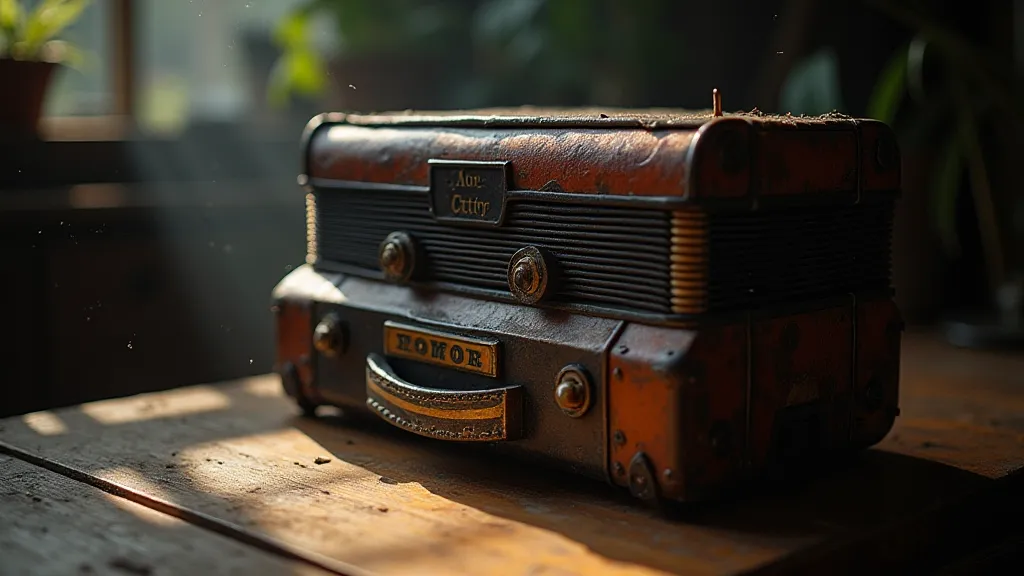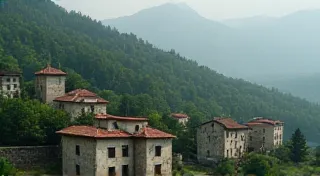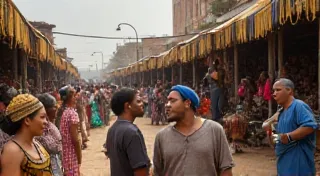The Cartographer's Whispers: Mapping the Landscape of Lost Oral Histories
There’s a peculiar magic held within antique accordions. Not just the music they can produce, a melancholic waltz or a joyous polka, but the resonance of hands long gone, the echoes of laughter and communal gatherings, the faint scent of a time vanished. Like oral traditions, they’re physical manifestations of shared cultural memory, vulnerable to the ravages of time and neglect. I remember finding one tucked away in my grandmother’s attic - a Hohner Monarch, its bellows cracked, its keys stubbornly silent. It wasn’t just an instrument; it was a portal to a past I barely understood. It sparked a fascination, not just with restoration, but with the stories it *could* have told. And it mirrored, in a tangible way, the urgent need to safeguard the equally fragile landscapes of regional storytelling.

The Ephemerality of Voice: Understanding the Landscape
Most regional stories aren't grand epics penned by celebrated authors. They are whispered around hearth fires, shared amongst families, and sung in local dialects. They are the folklore that binds communities, shaping their values, explaining their origins, and providing a framework for understanding the world. But unlike written texts, oral traditions are inherently ephemeral. They rely on the memory and skill of the storyteller, subject to alteration, embellishment, and eventual loss with each passing generation. Consider the Gaelic myths of Scotland, the Aboriginal Dreamtime stories of Australia, or the vibrant folktales of rural Japan. Each holds a unique cultural DNA, painstakingly transmitted through countless retellings, and each is increasingly at risk of fading into silence. The rich tapestry of narratives found in places like the Australian Outback, preserved through the powerful Lore of the Australian Outback: Dreamtime Stories and Aboriginal Culture, serves as a crucial example of this struggle for preservation.
Mapping these traditions isn't simply about recording the narrative itself. It’s about understanding the *context* that gave it life. What was the social structure of the community that birthed the story? What were their beliefs, their anxieties, their aspirations? How did the landscape—the mountains, rivers, forests—shape their worldview and influence the narrative? A seemingly simple tale of a mischievous forest spirit, for instance, might reveal deep-seated fears about the wilderness, a respect for its power, or a symbolic representation of social boundaries.
The Storyteller's Burden: Power, Transmission, and Transformation
The act of storytelling itself is rarely neutral. Within many cultures, storytelling roles are carefully guarded and passed down through specific lineages, often tied to gender, social status, or religious authority. The storyteller isn't merely conveying information; they're wielding a subtle form of power. They shape perceptions, reinforce values, and maintain the continuity of cultural memory. When these roles are disrupted – by colonialism, urbanization, or cultural assimilation – the transmission of stories can be severely compromised. It’s a challenge mirrored across cultures, even within communities where intergenerational trauma finds its way into regional narratives, as explored in Shadows of the Loom: Weaving Intergenerational Trauma into Regional Narratives.
Furthermore, narratives don't exist in a vacuum. They are constantly evolving, adapting to changing circumstances and incorporating new influences. A story might be subtly altered to reflect shifts in social norms, political ideologies, or religious beliefs. A character might be imbued with new traits, a plot twist might be added, or a moral lesson might be reinterpreted. These transformations, while seemingly minor, can dramatically alter the meaning and significance of the story over time. Recognizing these shifts is crucial for understanding the story’s trajectory and appreciating its resilience.
Ethical Considerations: Respecting the Voices of the Past
Approaching the documentation of oral traditions requires a profound sense of ethical responsibility. These aren’t just stories; they are often sacred knowledge, deeply intertwined with the identity and wellbeing of a community. It’s crucial to obtain informed consent from the community before recording or sharing their stories. This means explaining the purpose of the documentation, ensuring that they understand how the stories will be used, and respecting their right to refuse or to control the dissemination of the information. Acknowledging the source and attributing the story correctly is paramount, honouring the lineage and the original storyteller. Moreover, be mindful of potential sensitivities and power imbalances. Avoid exploiting the stories for personal gain or sensationalizing them for entertainment. The complexities of safeguarding these narratives often require a nuanced understanding of the communities that hold them.
The act of recording also carries a responsibility to ensure accuracy and avoid misrepresentation. This is particularly challenging with oral traditions, which are inherently fluid and subject to individual interpretation. Striving for faithfulness to the original narrative while acknowledging the limitations of the documentation process is vital. In essence, the cartographer isn't simply drawing a map; they are becoming a custodian of a living heritage. It's a role that calls for a sensitivity akin to the precision required to restore an antique accordion, ensuring its voice can be heard again.
Crafting Longevity: Techniques for Preservation and Understanding
So, how do we “map” these elusive traditions? It’s a multi-faceted approach that blends meticulous documentation with thoughtful analysis. Beyond simple recordings, which are themselves vulnerable to degradation, consider employing techniques that capture the essence of the storytelling experience. Detailed field notes, capturing nuances in tone, gesture, and context, are invaluable. Transcriptions should be accompanied by interpretive annotations, exploring the social, historical, and cultural significance of the narrative. Comparative analysis – examining multiple versions of the same story – can reveal patterns of transmission and transformation. Digital archives, coupled with metadata that includes information about the storyteller, the context of the recording, and the lineage of the story, are crucial for ensuring accessibility and longevity. The importance of understanding the cultural context is particularly evident in traditions like those of the Sami people, whose Tales of the Sami People: Legends of the Arctic Circle offer unique perspectives shaped by their environment and history.

For example, restoration of an accordion, like preserving oral traditions, requires both technical skill and profound respect for the instrument's history. You can't simply replace parts haphazardly; you must understand the original design, the materials used, and the craftsman’s intent. Similarly, when documenting oral traditions, it’s not enough to simply record the words; you must understand the cultural context, the storytelling techniques, and the values embedded within the narrative. Both endeavors demand patience, meticulousness, and a deep appreciation for the artistry of the past. The voices passed down through generations, often echoing across landscapes vastly different from their origins, carry a weight that demands thoughtful consideration and responsible stewardship. Consider the Maasai, whose cultural heritage is vividly expressed in their storytelling – a reflection of their nomadic lifestyle and deep connection to the land, highlighted in The Oral Traditions of the Maasai People: Stories of Warriors and Cattle.
The Future of Oral Traditions: Challenges and Opportunities
The rise of globalization and digital media presents both challenges and opportunities for the preservation of oral traditions. While technology can facilitate wider dissemination and accessibility, it also poses risks of cultural appropriation and misrepresentation. The homogenization of culture, driven by dominant media forms, can overshadow the unique voices and perspectives found within regional storytelling landscapes. The sheer volume of online content can make it difficult for traditional narratives to be heard amidst the noise, requiring deliberate efforts to curate and promote them.
However, digital platforms also offer powerful tools for engaging new audiences and fostering intercultural dialogue. Interactive storytelling apps, virtual reality experiences, and online archives can bring oral traditions to life in innovative ways, making them accessible to younger generations who may not have direct exposure to traditional storytelling practices. Collaborations between cultural practitioners, archivists, and technology experts can bridge the gap between traditional knowledge and digital innovation, ensuring that oral traditions are not lost to the sands of time.
Beyond the Narrative: The Importance of Cultural Context
It is crucial to remember that oral traditions are not simply collections of stories; they are integral components of cultural identity, social cohesion, and spiritual belief systems. They encode valuable knowledge about history, ecology, and social dynamics, providing insights that are often absent from written records. The act of listening to and sharing oral traditions is a form of cultural revitalization, reaffirming the value of traditional knowledge and fostering a sense of belonging within communities.
Furthermore, oral traditions often contain subtle critiques of power structures, challenging dominant narratives and providing a voice for marginalized groups. By amplifying these stories, we can contribute to a more equitable and inclusive society, recognizing the importance of diverse perspectives and challenging assumptions about knowledge and authority.
The Resonance of the Past: A Future of Shared Stories
The landscapes of regional storytelling are fragile, threatened by forces of globalization and cultural homogenization. But they are also remarkably resilient, capable of adapting and evolving in response to changing circumstances. By employing thoughtful documentation techniques, engaging with communities respectfully, and fostering a deep appreciation for the artistry of the past, we can ensure that these invaluable cultural artifacts continue to resonate for generations to come. The echoes of those accordions, played by hands now still, whisper a reminder: the stories are waiting to be heard, the maps waiting to be drawn. It is our responsibility to listen, to learn, and to share the richness of our shared human heritage.





